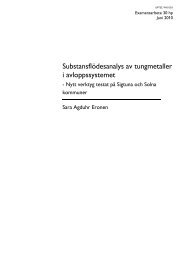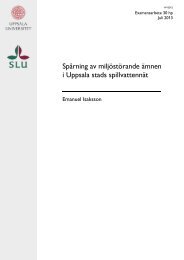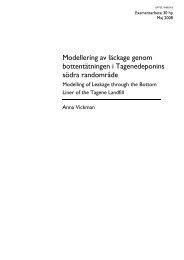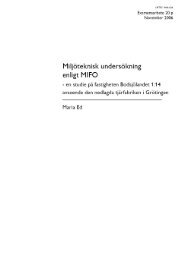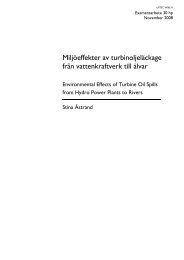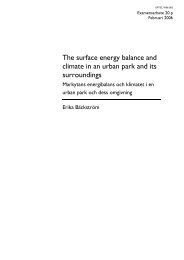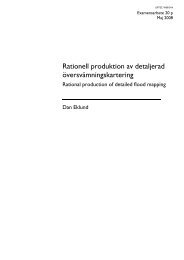Nutrient Transport Modelling in the Daugava River Basin - DiVA Portal
Nutrient Transport Modelling in the Daugava River Basin - DiVA Portal
Nutrient Transport Modelling in the Daugava River Basin - DiVA Portal
Create successful ePaper yourself
Turn your PDF publications into a flip-book with our unique Google optimized e-Paper software.
TemperaturePrecipitation20.00120degrees C15.0010.005.000.005.0010.00JanFebMarAprMayJunJulAugSepOctNovDecmm/month100806040200JanFebMarAprMayJunJulAugSepOctNovDecFigure 3. Monthly average temperature and precipitation <strong>in</strong> <strong>the</strong> <strong>Daugava</strong>bas<strong>in</strong>, 19801999 (BALTEX Hydrological Data Centre data base, 2004).3.1.3 Geology and land useThe <strong>Daugava</strong> <strong>River</strong> bas<strong>in</strong> is covered by glacial deposits to depths of 200 m. Most of<strong>the</strong>se deposits consist of Weichselian (Latvian) Glacial characterised by till, sandy tilland glaciolacustr<strong>in</strong>e sand. There are also alluvial deposits from after <strong>the</strong> ice age(Roz<strong>in</strong>s, 2001).About half of <strong>the</strong> bas<strong>in</strong> area consists of agricultural land. The Belarusian part of <strong>the</strong>bas<strong>in</strong> has <strong>the</strong> largest area of cultivated land. In <strong>the</strong> Russian part of <strong>the</strong> bas<strong>in</strong> <strong>the</strong>re is alsoa considerable amount of agricultural land, but more than half of <strong>the</strong> land <strong>in</strong> this area isforested. In <strong>the</strong> Latvian part of <strong>the</strong> bas<strong>in</strong> about half of <strong>the</strong> land is agricultural and 30 %is covered with forests (Hannerz and Destouni, 2005). The percentage of different landuses <strong>in</strong> <strong>the</strong> part of each country that belongs to <strong>the</strong> <strong>Daugava</strong> Bas<strong>in</strong> is presented <strong>in</strong>table 1. In figure 2 <strong>the</strong> distribution of different types of land use <strong>in</strong> <strong>the</strong> bas<strong>in</strong> is shown.This is <strong>the</strong> GIS data that were used to determ<strong>in</strong>e <strong>the</strong> area of each land use which isrequired as model <strong>in</strong>put by <strong>the</strong> GWLF. Artificial surfaces <strong>in</strong>clude urban areas and roads.Cultivated land consists of managed areas and mosaic areas of crops and trees.Herbaceous land is natural scrub, pasture, steppe and heath. Lichens and wetlands is aquite heterogeneous land use category and <strong>in</strong>clude lichen, moss, bog, peat and floodedherbaceous areas. Forests are divided <strong>in</strong>to three land use categories; coniferous forest,deciduous forest and mixed forest (both coniferous and deciduous trees). The last landuse category represented <strong>in</strong> <strong>the</strong> bas<strong>in</strong> is water, which <strong>in</strong>cludes all open water surfaceslike lakes and rivers (Ibid.).Table 1. Percent of each land use <strong>in</strong> <strong>the</strong> part of each country that belongsto <strong>the</strong> <strong>Daugava</strong> <strong>River</strong> bas<strong>in</strong> and for <strong>the</strong> entire bas<strong>in</strong> (Hannerz and Destouni, 2005)Land use category Area percentage for each country and for <strong>the</strong> entire bas<strong>in</strong>Latvia Belarus Estonia Lithuania Russia <strong>Daugava</strong> Bas<strong>in</strong>Artificial surfaces 1 0 0 0 0 1Cultivated land 47 63 38 41 42 51Herbaceous land 18 1 2 19 0 6Lichens and wetlands 0 0 0 1 1 1Forest 31 34 57 32 54 40Water 2 1 3 7 1 26



